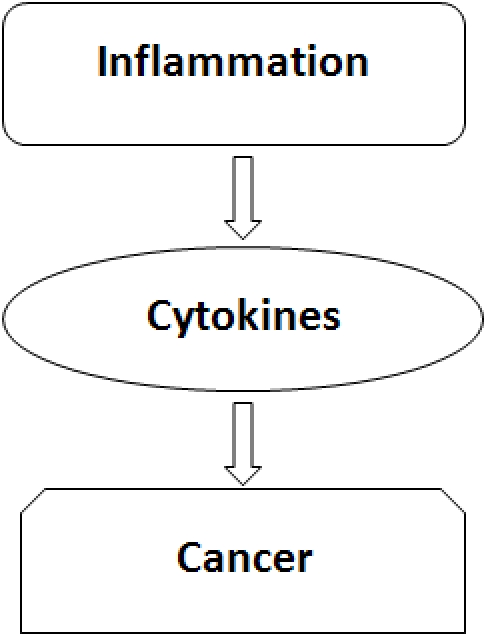Abstract
Cytokines play an important role in the evolution of inflammatory processes. Therefore, they are also key components of the cancer evolution, a disease recognized to depend on chronic inflammation. On the whole, we define cytokinome as the totality of these proteins and their interactions in and around biological cells. Understanding the complex interaction network of cytokines in patients affected from cancers should be very useful both to follow the cancer evolution from its early steps and to define innovative therapeutic strategies by using systems biology approaches.
Keywords: cytokine, chronic inflammation, cancer, systems biology
Background & Description
Inflammation is a physiological process in response to acute tissue damage resulting from physical injury, ischemic injury, infection, exposure to toxins, chemical irritation, and/or other types of trauma. Moreover, it is a protective attempt by the organism to remove the injurious stimuli as well as initiate the healing process for the tissue. Inflammation may become chronic when an inflammatory stimulus persists. Some authors have suggested the correlation between chronic inflammation and cancer. In fact, while the inflammatory diseases increase the risk of developing many types of cancer, some non-steroidal anti-inflammatory drugs reduce this risk for certain cancers (for example, breast cancer) as well as their mortality. Interestingly, inflammation is involved in all three stages of tumor development: initiation, progression and metastasis.
Cytokines are among molecules that play an important role in the evolution of these processes. They are proteins that are expressed before and during the inflammatory process and play a key role at the various disease levels so that they can be considered as specific markers of cancer and of its specific evolutive steps (Figure 1). It is now clear that these proteins profoundly alter the metabolic pathways and, therefore, the homeostasis of the organism.
Figure 1.

Relationship between inflammation, cytokines and cancer
In order to understand the whole universe of human cytokines, the socalled cytokinome, according the “omics” system of definition, it needs to evaluate these proteins and analyse their complex network of interactions by which they regulate their own synthesis or that of their receptors, and antagonize or synergize with each other in many and often redundant ways. A major effort is the achievement of an efficient database that can collect together correct ontologies, algorithms and tools of analyses, structural and “omics” data of cytokines and their receptors, metabolic pathways, and the whole interactome. Another intriguing problem related to the cytokine family and their receptors is the pleiotropy existing in the cytokine system, where one cytokine is able to activate various receptors and many different cytokines activate the same receptor. When the frame of the whole cytokine network will be known, we will have the possibility to create best and more efficient drugs against the cancer, most probably able to interact with the receptors rather than directly with the cytokine molecules because of their pleiotropic effect. Another element of complexity in the cytokine network is introduced also by the fact that some genes encoding cytokines can give rise to variant forms of cytokines (isoforms) by means of alternative splicing, yielding molecules with slight structural differences but biologically significant changes of activities. This explains why it is always useful to analyze the gene expression profile correlated to the cytokines. In fact, previous studies have identified important mutations in lung cancers, but they were primarily focused on a limited set of genes and, thus, provided a constrained view of the mutational spectrum. Recent cancer sequencing efforts have used next-generation sequencing technologies to provide a genome-wide view of mutations in leukaemia, breast cancer and cancer cell lines.
However, a correct and comprehensive understanding of cytokine functions can be obtained from simultaneous and coherent measurements of the serum concentrations of cytokines. This point raises the inherent difficulty of a simultaneous measurement of the cytokine concentrations to obtain correct internal ratios among the various molecules present in the same biological fluid due to the often large difference in concentrations spanning several magnitude orders. At present, it is possible to effectively characterize the serum levels of cytokines using a broad-spectrum beadbased multiplex immunoassay.
In this complex interactions network, Systems Biology and/or Biologically Integrated Approaches are powerful tools to analyze as a whole, the enormous amount of data coming from the so-called “omics” disciplines (genomics, transcriptomics, proteomics) by computational methods and algorithms, in order to create an information body that allows us to have a comprehensive and integrated vision of the biological phenomenon under investigation. These datasets can be analyzed and modelled computationally by using graphs or networks connecting the various data groups (related to gene and protein expression obtained by microarrays and by multiplex biometric ELISA-based immunoassay) in terms of dynamicprobabilistic maps of metabolic and/or physiological activities and/or pathogenetic pathways. Therefore, the definition and evaluation of a human cytokinome is an important future tool to analyze the interaction network of cytokines both in healthy individuals and in patients affected from a cancer. Using these computational models it will be easier and immediate to understand and investigate how the regression of a chronic inflammation process, by acting on the cellular populations of cytokines, can block the progression of the cancer and how this knowledge can be an useful prognostic and diagnostic tool for clinicians.
Footnotes
Citation:Costantini et al; Bioinformation 5(4): 166-167 (2010)


